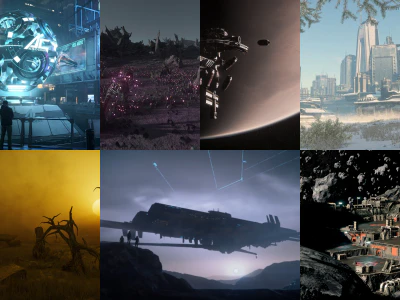
Locations in the Star Citizen universe are extremely diverse, ranging from lush Earth-like planets full of pristine wilderness to encumenopolises with every square inch of the planet covered in high tech supercity; from small seedy refueling space stations to a cobbled together pirate mega-station; from a bio-luminescent moon orbiting a rogue gas giant to the smashed corpse of a planet turned into an electrically charged asteroid formation full of industrial mining outposts and criminal hideouts alike. In total, there are 95 known star systems, consisting of 324 planets, 74 moons, 50 space stations and 76 asteroid formations, plus some even stranger sights.[annotation 1]
Systems
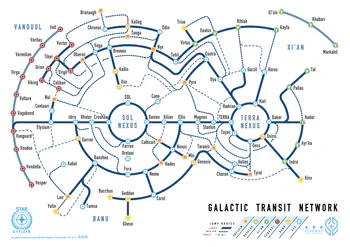
A system (short for planetary system) consists of one or more non-stellar objects that orbit one or more gravitational governors (such as stars or black holes). There are 4 main factions that claim ownership over these systems: the United Empire of Earth, the Vanduul, the Xi'an Empire, and the Banu Protectorate. There are also two other categories of system affiliation - developing and unclaimed. Many systems are connected to one another by jump points of varying sizes, allowing for interstellar travel between systems in ships equipped with a jump drive.
Planets
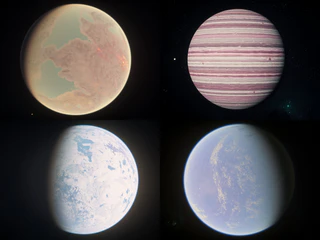
A planet is an object that orbits one or more stars, is massive enough to be rounded by its own gravity, and has cleared most of its orbit of other astronomical objects.[1] There are 324 known planets of various classifications, depending on the atmosphere, size, and geological composition.[annotation 1] These classifications include terrestrial rocky, super earth, ocean planet, gas giant, ice giant, smog planet, mesoplanet, protoplanet, dwarf planet, and desert planet, among others.
Moons
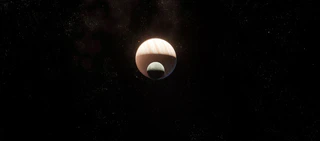
A moon, also known as a natural satellite - is an astronomical object that orbits a planet.[2] There are 74 known moons. While they do not have classifications in the same way that planets do, there are many different types of moon, from dry, desert moons like Daymar, to frigid, frozen examples like Calliope, to those with dense smog-like atmospheres such as Aberdeen.
Asteroid formations
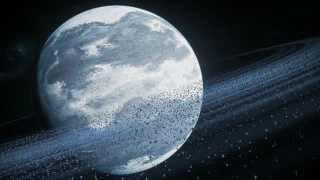
An asteroid is a rocky object smaller than a planet, often in massive groupings with other asteroids - know as asteroid formations. These objects are the remnants of the formation of the larger bodies in the system, or sometimes are the result of collisions between a planet and moon or between two planets.[3] There are 76 charted asteroid formations, usually found as system rings, with the occasional asteroid cluster and single planetoid asteroid.
Planetoid
A planetoid is a larger asteroid with a proper gravity field sufficient to shape the body into an ellipsoid under its own weight. The two most notable planetoids are Delamar, which is home to a colony of radical independents in the Nyx system, as well as the Space Whale, a unique looking planetoid frequently visited by tourists of the Nemo system.
Space Stations

A space station is an artificial satellite, i.e., a man made construction that is orbiting a star, planet or moon, usually with some amenities for passing ships to make use of, or otherwise with a specific function such as security or scientific research. There are 50 space stations in the Star Citizen universe, ranging from small truck-stop-like rest stops to super stations such as Spider - and everything in between.
Caves
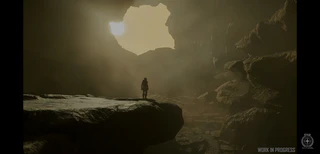
Caves and caverns are natural or artificial cavities in the ground. They are generated by plate tectonic mechanics, weathering or artificial excavation.
Outposts
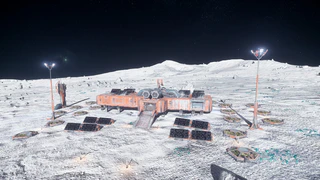
An outpost is a small to medium sized development on the surface of a planet or moon. Outposts can have a variety of different types of architecture and functions, ranging from utilitarian modular mining outposts to colonial style homesteads.
Settlements

Settlements are a type of development that are more extensive than outposts, usually starting from a single outpost or facility and expanded over time in an ad hoc manner. These can come in a number of different forms, from underground tunnels, to trading towns, to active or former research/mining bases. Often times, due to the nature of how they came about, these locations may be occupied by some of the less savory elements of society.
Cities

Many planets in developed systems contain one or more cities, also known as landing zones. The architecture of these cities varies, depending the ownership and affiliation of each planet and system. In order to access cities, players must land at the spaceport. From there, they can access the other parts of the city by using the transit system.
See also
External links
Annotations
- ↑ Jump up to: 1.0 1.1 This section is last updated on 2020-05-25.